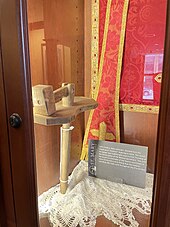Crotalus (instrument)

A crotalus (
Etymology
The
Appearance and use

Made from wood, the particular style and manner of noise-making varies between different clappers. Some use an integral hammer that strikes the wood, while others use a piece of wood that rides over a gear to make a clicking noise.[10] Historian James Stevens Curl considered the crotalus a descendant of earlier sistrum, an ancient Egyptian ritual instrument. Historically, the crotalus was common in Maundy Thursday Ethiopic liturgies.[11]
The Memoriale Rituum, a former
In Rome, the instrument sometimes appears similar to baby rattles.[6] The crotalus is used during the Austrian Holy Week tradition of Ratcheting (German: Ratschen), wherein children will alternate between ratcheting and chanting, with a reward typically following.[16]
See also
- Christus factus est
- Epiclesis
- Liturgical dance
- Tenebrae
References
- ^ a b Tenorio, Rich (16 August 2016). "When the Spanish Inquisition expanded to the New World". The Times of Israel. Archived from the original on 9 May 2021. Retrieved 29 June 2022.
- ISBN 978-0-7735-7607-0.
- ^ a b Schulte, A.J. (1907). "Altar Bell". Catholic Encyclopedia. Vol. 1. New York City: Robert Appleton Company. Archived from the original on 19 September 2021. Retrieved 29 June 2022 – via NewAdvent.
- ^ Broderick, Robert C., ed. (1944). "Crotalum". Concise Catholic Dictionary. Catechetical Guild Educational Society. p. 104.
- ISBN 9780854963652.
- ^ a b c Sonnen, John Paul (2 April 2018). "The Art of the Paschal Triduum: The Crotalus". Liturgical Arts Journal. Archived from the original on 16 April 2022. Retrieved 29 June 2022.
- ^ "A Glossary of Churchly Terms". Boston: Church of the Advent. Retrieved 6 April 2023.
- ^ Beckwith, Tom (9 April 2022). "The Crotalus". Denver: St. Michael and All Angels' Episcopal Church. Retrieved 6 April 2023.
- ^ A Dictionary of Greek and Roman Antiquities, CRO´TALUM
- ^ Nevins, Albert J., ed. (1965). "Clapper". The Maryknoll Catholic Dictionary. New York City: Dimension Books. pp. 131–132.
- ^ Curl, James Stevens (7 March 2023). "A Marian Odyssey". Anglicanism.org. Retrieved 6 April 2023.
- ^ Rousselle, Christine (2 April 2023). "Holy Week leads the faithful to Easter Sunday: Here are the special days observed and what they mean". Fox News. Retrieved 6 April 2023.
- ^ "Part IV: Thursday, the Day of the Lord's Supper". Memoriale Rituum. Glasgow: R. & T. Washbourne, Ltd. 1906. Archived from the original on 26 July 2021. Retrieved 29 June 2022.
- ^ Attwater, Donald (1958). "Clapper". A Catholic Dictionary (3rd ed.). New York City: Macmillan Company. p. 100.
- ^ "Full Text of the Union of Brest-Litovsk". Munster, IN: St. Josaphat Ukrainian Greek Catholic Church. Retrieved 2 July 2022.
- ^ "Ratcheting During Holy Week". Austria: UNESCO. 2015. Retrieved 30 June 2022.
